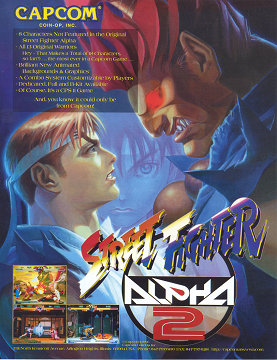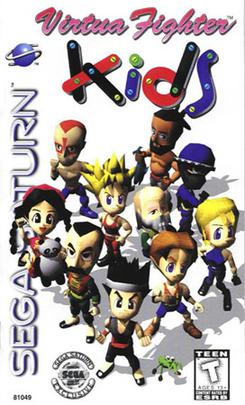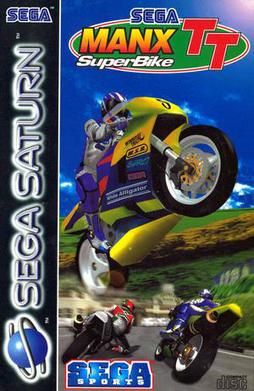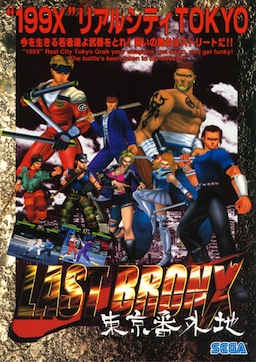
Virtua Fighter is a fighting game created for the Sega Model 1 arcade platform by AM2, a development group within Sega, headed by Yu Suzuki. An early prototype version was location tested in Japan by August 1993, before the complete game was released worldwide in December 1993. It was the first arcade fighting game to feature fully 3D polygon graphics. The game was ported to Sega Saturn as a global launch title in 1994 and 1995, and also received a port to the Sega 32X.

Sega Rally Championship is a 1995 racing game developed and published by Sega. Originally released for arcades using the Sega Model 2 board, ports were published for the Sega Saturn in 1995 and Microsoft Windows in 1997. The Sega Rally Championship simulates driving on different surfaces, with different friction properties, with the car's handling changing accordingly. As the first racing game to incorporate this feature, Sega Rally Championship is considered to be one of the milestones in the evolution of the racing game genre. It was also an early rally racing game and featured cooperative gameplay alongside the usual competitive multiplayer.

Street Fighter Alpha 2, known as Street Fighter Zero 2 in Japan, Asia, South America, and Oceania, is a 1996 fighting game originally released for the CPS II arcade hardware by Capcom. The game is a remake of the previous year's Street Fighter Alpha: Warriors' Dreams and features a number of improvements, such as new attacks, stages, endings, and gameplay features. It was ported to the PlayStation, Sega Saturn and Super Nintendo home consoles globally in 1996, and later a Windows port. It was followed by Street Fighter Alpha 3 in 1998.

Olympic Summer Games is an official video game of the Atlanta 1996 Olympic Games. It is the successor to Olympic Gold and Winter Olympics. It was the last "Olympic" video game released for the fourth generation of consoles, as well as the Game Boy.

Virtua Cop 2 is a light gun shooter arcade game, released in 1995 and developed internally at Sega by their AM2 studio. It was ported to the Sega Saturn in 1996, PC in 1997, and Sega Dreamcast in 2000. It was bundled with Virtua Cop in Virtua Cop: Elite Edition for PlayStation 2 in 2002.

Die Hard Arcade, known as Dynamite Deka in Japan, is an arcade beat 'em up video game released by Sega. It was the first beat 'em up to use texture-mapped 3D polygon graphics, and used a sophisticated move set by contemporary beat 'em up standards, often being likened to a fighting game in this respect. It also features quick time events, the ability to combine items to make more powerful weapons, and in two-player mode the ability to perform combined special moves and combos.

Virtua Fighter Kids is a 1996 installment in the Virtua Fighter fighting game series, and a super deformed version of Virtua Fighter 2. It was developed by Sega AM2 on the ST-V arcade board, unlike Virtua Fighter 2's hardware; it was also ported to the Sega Saturn home console.

Virtua Fighter 3 is a 1996 fighting game developed and published by Sega, the sequel to 1994's Virtua Fighter 2 as part of the Virtua Fighter series. Released originally on arcades, an updated version named Virtua Fighter 3tb was later made with the addition of team battles. This updated version of the game was ported to the Dreamcast home console in 1998 after the cancellation of a Sega Saturn port.

The Lost World: Jurassic Park is a light gun arcade game from Sega. It was released in 1997, and is based on the film of the same name. It is also a sequel to Sega's 1994 Jurassic Park arcade game. A third Jurassic Park arcade game, based on Jurassic Park III, was made by Konami in 2001.

Dead or Alive is a 1996 fighting game by Tecmo and the first entry in the Dead or Alive series. Built on the Sega Model 2 hardware, it was released first in arcades in 1996, followed by home ports for the Sega Saturn in Japan during 1997, and for the PlayStation in all regions during 1998.

Rad Mobile is a racing arcade game developed by Sega AM3 and published by Sega. It was first published in Japan in October 1990, followed by an international release for arcades in February 1991. Rad Mobile was Sega's first 32-bit game, using Sega's System 32 arcade system board. It was also the first ever appearance of Sonic the Hedgehog, who appears as an ornament hanging from the driver's rearview mirror.

Virtual On: Cyber Troopers is a 3D action video game developed and published by Sega. A robot-themed shooter and fighter, it was developed on the Sega Model 2 hardware and released on arcades in January 1996 before ports to the Sega Saturn that year and to Windows the next year. Initially the game was to be released under the title "Virtual On" in Japan and "Cyber Troopers" in North America, but ultimately these two names were combined into a single title for both regions.

Special Criminal Investigation, also known as S.C.I. for short or as Chase HQ II: Special Criminal Investigation in some home versions, is vehicular combat racing game published by Taito for arcades in 1989. It is the sequel to the 1988 game Chase H.Q.
Virtua Fighter is a series of fighting games created by Sega AM2 and designer Yu Suzuki. The original Virtua Fighter was released in December 1993 and has received four main sequels and several spin-offs. The highly influential first Virtua Fighter game is widely recognized as the first 3D fighting game released. The latest mainline release was Virtua Fighter 5 in 2006; this version has since been continously updated.

Sega Touring Car Championship is an arcade racing game released by Sega's AM Annex for the Model 2 mainboard in 1996. It was later ported to the Sega Saturn and Microsoft Windows.

Manx TT Super Bike is a 1995 arcade racing game developed jointly by Sega AM3 and Sega-AM4. It is a motorcycle racing game built for the Sega Model 2 arcade board. Up to 8 players can race in this game if enough arcade cabinets are linked together, following on from Daytona USA. It was later ported to the Sega Saturn by Tantalus Interactive and to Windows by Perfect Entertainment.

Last Bronx is a 1996 3D fighting video game developed by Sega AM3 on the Sega Model 2 mainboard. It was released in Japanese and American arcades before home versions were produced in for the contemporary Sega Saturn and Windows systems in 1997. Set in a crime-ridden Tokyo, the game follows rival street gangs who take part in a weapon fighting tournament. Last Bronx became a big hit in Japan, and it was soon novelized and serialized into comics and radio drama, and a year later Takashi Shimizu directed the direct-to-video live-action movie. On June 29, 2006, Sega released Last Bronx on PlayStation 2 as a tenth anniversary celebration.

Daytona USA: Championship Circuit Edition, or Daytona USA: Circuit Edition in Japan, is a racing game by Sega, specifically designed for the Sega Saturn. Released in 1996, it is a reworked and extended version of the original Daytona USA, and was developed by Sega AM3, the same team that oversaw the Saturn port of Sega Rally Championship, by using a modified version of the Sega Saturn engine of Sega Rally Championship.

Top Skater is an arcade skateboarding sports video game released by Sega in 1997, and built on the Sega Model 2 hardware. It was one of the first arcade games to feature a skateboard controller interface. The game was directed by Kenji Kanno.

Winter Heat is a sports video game developed by Sega AM3 and published by Sega for arcades in 1997, and for the Sega Saturn in 1998, featuring the license for the 1998 Winter Olympics that were celebrated in Nagano, Japan. It is the sequel to the 1996 Sega game DecAthlete. Winter Heat was released on the PlayStation 2 in Japan as part of the DecAthlete Collection with DecAthlete and Virtua Athlete. The collection is the 15th volume of the Sega Ages 2500 series.




















